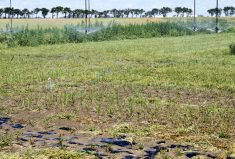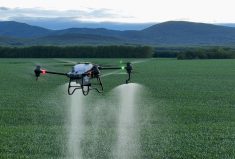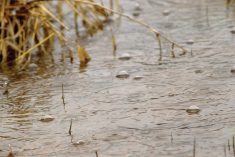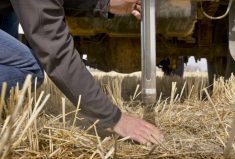When you’re standing on your land, you’re atop an ecosystem with a diversity rivalling that of a coral reef.

“Soil organisms are abundant and varied — you can find anywhere from 100 to 100,000 individuals in a single square metre of soil,” soil ecologist Jeff Battigelli told attendees at the recent Western Canada Soil Health Conference.
“In a single square metre, you can find anywhere from 250 to 300 species. From a diversity perspective, that’s a lot of species in a small area.”
And all of those critters are busy working for you, added the consultant and researcher from St. Albert.
“The ecosystems services provided by soil fauna and soil flora are equivalent to $1.2 trillion to $2.3 trillion. That’s a lot of service for free.”
These organisms break down organic matter so it is more available to other organisms, cycle nutrients, and play a key role in continual carbon, nitrogen, phosphorus, and sulphur cycles taking place in soil.

There are four main types of soil organisms. The smallest are microflora, which include bacteria and fungi.
“You need a good microscope to see these guys,” said Battigelli.
There are three classes of ‘fauna,’ which are grouped by size. Microfauna are less than one-fifth of a millimetre in size, and include nematodes and protozoa, which live in the soil water film (little bits of water that accumulate on the soil particles).
- Read more: What happens above changes the world below
Mites and springtails are examples of mesofauna, which range from 0.2 to 10 millimetres in size. Mites, known as Acari, account for the bulk of soil organisms, and come in a variety of sizes, shapes, and colours. They can be predators, parasites, herbivores, or detritivores (which feed off decomposing matter).
Read Also

New crop insurer policy enables easier startup for faba beans
Agriculture Financial Services Corporation updated its normals for faba beans, which may open the door for more Canadian producers to feel comfortable growing the pulse crop in the future.
Macrofauna, 10 millimetres or bigger, can be seen with the naked eye, and include ants, earthworms, centipedes, beetles, and bugs.
About 80 to 90 per cent of all soil organisms live in organic matter in the top five to 10 centimetres of soil. Each adapts to the very specific conditions of its section of soil, and populations change according to soil pH. For example, when a soil is less acidic, there will be fewer earthworms and more fungi, springtails, and mites.
The diversity and density of organisms also change seasonally. From the last frost in spring until early summer as plants and roots start to grow, food is abundant, and soil organisms begin reproducing. During the summer months, the density drops off as things dry up and warm up. By fall, populations jump up again as leaves dry up and roots start to die.

“You have that extra flush of nutrients that are showing up in the soil system to allow for the extra bump of activity during that season,” said Battigelli.
Mesofauna and macrofauna aren’t just involved in decomposition and nutrient cycling, but also inoculation and transportation of microfauna. They carry spores with them as they move through the soil profile and inoculate new organic matter to allow the decomposition process to continue in the soil ecosystem. They also change the soil profile by moving nutrients and organic matter about.
Both flora and fauna store nutrients in their own biomass as they feed on the organic matter. These nutrients are released when they excrete waste or are eaten by other organisms. As the soil organisms feed on organic matter, they immobilize nutrients and that prevents them from being leached away and lost.
“It’s almost like little Contac C capsules that are just releasing nutrients in a timely fashion, that the plants are going to be able to use,” said Battigelli.
Your soil, in short, is a very busy place.
Growers don’t have to be experts on soil microbiology, but they should be aware that soil health and healthy crops are directly related, he said.
“All above-ground habitat and variety and all the things you see have been made possible by the things below ground — and that’s one thing to keep in mind,” said Battigelli.
















